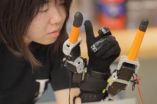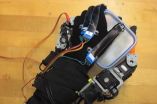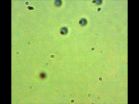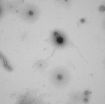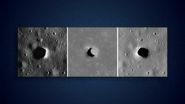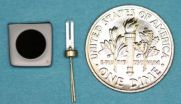(Press-News.org) CAMBRIDGE, MA -- Twisting a screwdriver, removing a bottle cap, and peeling a banana are just a few simple tasks that are tricky to pull off single-handedly. Now a new wrist-mounted robot can provide a helping hand — or rather, fingers.
Researchers at MIT have developed a robot that enhances the grasping motion of the human hand. The device, worn around one's wrist, works essentially like two extra fingers adjacent to the pinky and thumb. A novel control algorithm enables it to move in sync with the wearer's fingers to grasp objects of various shapes and sizes. Wearing the robot, a user could use one hand to, for instance, hold the base of a bottle while twisting off its cap.
"This is a completely intuitive and natural way to move your robotic fingers," says Harry Asada, the Ford Professor of Engineering in MIT's Department of Mechanical Engineering. "You do not need to command the robot, but simply move your fingers naturally. Then the robotic fingers react and assist your fingers."
Ultimately, Asada says, with some training people may come to perceive the robotic fingers as part of their body — "like a tool you have been using for a long time, you feel the robot as an extension of your hand." He hopes that the two-fingered robot may assist people with limited dexterity in performing routine household tasks, such as opening jars and lifting heavy objects. He and graduate student Faye Wu presented a paper on the robot this week at the Robotics: Science and Systems conference in Berkeley, Calif.
Biomechanical synergy
The robot, which the researchers have dubbed "supernumerary robotic fingers," consists of actuators linked together to exert forces as strong as those of human fingers during a grasping motion.
To develop an algorithm to coordinate the robotic fingers with a human hand, the researchers first looked to the physiology of hand gestures, learning that a hand's five fingers are highly coordinated. While a hand may reach out and grab an orange in a different way than, say, a mug, just two general patterns of motion are used to grasp objects: bringing the fingers together, and twisting them inwards. A grasp of any object can be explained through a combination of these two patterns.
The researchers hypothesized that a similar "biomechanical synergy" may exist not only among the five human fingers, but also among seven. To test the hypothesis, Wu wore a glove outfitted with multiple position-recording sensors, and attached to her wrist via a light brace. She then scavenged the lab for common objects, such as a box of cookies, a soda bottle, and a football.
Wu grasped each object with her hand, then manually positioned the robotic fingers to support the object. She recorded both hand and robotic joint angles multiple times with various objects, then analyzed the data, and found that every grasp could be explained by a combination of two or three general patterns among all seven fingers.
The researchers used this information to develop a control algorithm to correlate the postures of the two robotic fingers with those of the five human fingers. Asada explains that the algorithm essentially "teaches" the robot to assume a certain posture that the human expects the robot to take.
Bringing robots closer to humans
For now, the robot mimics the grasping of a hand, closing in and spreading apart in response to a human's fingers. But Wu would like to take the robot one step further, controlling not just position, but also force.
"Right now we're looking at posture, but it's not the whole story," Wu says. "There are other things that make a good, stable grasp. With an object that looks small but is heavy, or is slippery, the posture would be the same, but the force would be different, so how would it adapt to that? That's the next thing we'll look at."
Wu also notes that certain gestures — such as grabbing an apple — may differ slightly from person to person, and ultimately, a robotic aid may have to account for personal grasping preferences. To that end, she envisions developing a library of human and robotic gesture correlations. As a user works with the robot, it could learn to adapt to match his or her preferences, discarding others from the library. She likens this machine learning to that of voice-command systems, like Apple's Siri.
"After you've been using it for a while, it gets used to your pronunciation so it can tune to your particular accent," Wu says. "Long-term, our technology can be similar, where the robot can adjust and adapt to you."
Down the road, Asada says the robot may also be scaled down to a less bulky form.
"This is a prototype, but we can shrink it down to one-third its size, and make it foldable," Asada says. "We could make this into a watch or a bracelet where the fingers pop up, and when the job is done, they come back into the watch. Wearable robots are a way to bring the robot closer to our daily life."
INFORMATION:
Written by Jennifer Chu, MIT News Office
Getting a grip on robotic grasp
New wrist-mounted device augments the human hand with two robotic fingers
2014-07-18
ELSE PRESS RELEASES FROM THIS DATE:
Biomarker discovery may lead to new HIV treatment
2014-07-18
Further analysis of a Phase II study of therapeutic HIV vaccine candidate Vacc-4x revealed a potential biomarker associated with participants who experienced a more profound viral load reduction after receiving the vaccine. The results of this exploratory, ad hoc, subset analysis by St George's, University of London and Bionor Pharma were announced today at the AIDS 2014 Conference in Melbourne, Australia.
If confirmed, the biomarker may be able to predict which patients will benefit most from the therapeutic HIV vaccine candidate Vacc-4x, which is being developed by ...
'Nanocamera' takes pictures at distances smaller than light's own wavelength
2014-07-17
VIDEO:
This is a video demonstrating scanning-stage-based exposure, whereby programmed
motion of a microscope stage is used to write the University's "Block I " logo into the plasmonic film. Each bar in the...
Click here for more information.
Researchers at the University of Illinois at Urbana-Champaign have demonstrated that an array of novel gold, pillar-bowtie nanoantennas (pBNAs) can be used like traditional photographic film to record light for distances that ...
Tiniest catch: University of Arizona scientists' fishing expedition reveals viral diversity in the sea
2014-07-17
A fishing expedition of microscopic proportions led by University of Arizona ecologists revealed that the lines between virus types in nature are less blurred than previously thought.
Using lab-cultured bacteria as "bait," a team of scientists led by Matthew Sullivan has sequenced complete and partial genomes of about 10 million viruses from an ocean water sample in a single experiment.
The study, published online on July 14 by the journal Nature, revealed that the genomes of viruses in natural ecosystems fall into more distinct categories than previously thought. This ...
Lunar pits could shelter astronauts, reveal details of how 'man in the moon' formed
2014-07-17
VIDEO:
This video shows images from NASA's LRO spacecraft of various lunar pits.
Click here for more information.
While the moon's surface is battered by millions of craters, it also has over 200 holes – steep-walled pits that in some cases might lead to caves that future astronauts could explore and use for shelter, according to new observations from NASA's Lunar Reconnaissance Orbiter (LRO) spacecraft.
The pits range in size from about 5 meters (~5 yards) across to more than ...
Older adults who walk out of necessity are at highest risk for outdoor falls
2014-07-17
Older adults are at a greater danger of falling when walking for utilitarian purposes such as shopping and appointments than when walking for recreation, according to a study from UMass Medical School.
"Older adults have two times the risk of falling while walking out of necessity than walking for recreation, and four times greater risk of injury from a fall on a sidewalk than in a recreational area," said Wenjun Li, PhD, associate professor of medicine in the Division of Preventive and Behavioral Health at UMMS and lead author of the study "Utilitarian Walking, Neighborhood ...
Estimating earthquake frequency and patterns in the Puget Lowland
2014-07-17
Boulder, Colo. - The hazard posed by large earthquakes is difficult to estimate because they often occur hundreds to thousands of years apart. Because written records for the Puget Lowland of northwestern Washington cover less than 170 years, the size and frequency of the largest and oldest earthquakes on the Seattle and Tacoma faults are unknown. Past earthquakes can only be estimated through geologic studies of sediments and landforms that are created when faults break the ground surface.
Along the Cascadia margin, the cities of Seattle and Tacoma occupy the Puget ...
Discovery may make it easier to develop life-saving stem cells
2014-07-17
Not unlike looking for the proverbial needle in a haystack, a team of Michigan State University researchers have found a gene that could be key to the development of stem cells – cells that can potentially save millions of lives by morphing into practically any cell in the body.
The gene, known as ASF1A, was not discovered by the team. However, it is at least one of the genes responsible for the mechanism of cellular reprogramming, a phenomenon that can turn one cell type into another, which is key to the making of stem cells.
In a paper published in the journal Science, ...
Losing sleep over your divorce? Your blood pressure could suffer
2014-07-17
Those who experience persistent sleep problems after a divorce stand to suffer from more than just dark circles. They might also be at risk for potentially harmful increases in blood pressure, a new study finds.
A growing body of research links divorce to significant negative health effects and even early death, yet few studies have looked at why that connection may exist.
Divorce-related sleep troubles may be partly to blame, suggest the authors of a new study to be published in a forthcoming issue of the journal Health Psychology.
"In the initial few months after ...
Choosing cheese
2014-07-17
Go ahead and call Rachel Dutton's research cheesy if you must. As far as she's concerned, it's anything but an insult.
A Bauer Fellow at the Faculty of Arts and Sciences' Center for Systems Biology, Dutton and her lab study cheese – or more precisely – the bacteria and fungi that live on cheese, in an effort to better understand how microbial communities form.
After studying 137 varieties of cheese collected in 10 different countries, Dutton has been able to identify three general types of microbial communities that live on cheese, opening the door to using each as ...
Future electronics may depend on lasers, not quartz
2014-07-17
Nearly all electronics require devices called oscillators that create precise frequencies—frequencies used to keep time in wristwatches or to transmit reliable signals to radios. For nearly 100 years, these oscillators have relied upon quartz crystals to provide a frequency reference, much like a tuning fork is used as a reference to tune a piano. However, future high-end navigation systems, radar systems, and even possibly tomorrow's consumer electronics will require references beyond the performance of quartz.
Now, researchers in the laboratory of Kerry Vahala, the ...
LAST 30 PRESS RELEASES:
Numbers in our sights affect how we perceive space
SIMJ announces global collaborative book project in commemoration of its 75th anniversary
Air pollution exposure and birth weight
Obstructive sleep apnea risk and mental health conditions among older adults
How talking slows eye movements behind the wheel
The Ceramic Society of Japan’s Oxoate Ceramics Research Association launches new international book project
Heart-brain connection: international study reveals the role of the vagus nerve in keeping the heart young
Researchers identify Rb1 as a predictive biomarker for a new therapeutic strategy in some breast cancers
Survey reveals ethical gaps slowing AI adoption in pediatric surgery
Stimulant ADHD medications work differently than thought
AI overestimates how smart people are, according to HSE economists
HSE researchers create genome-wide map of quadruplexes
Scientists boost cell "powerhouses" to burn more calories
Automatic label checking: The missing step in making reliable medical AI
Low daily alcohol intake linked to 50% heightened mouth cancer risk in India
American Meteorological Society announces Rick Spinrad as 2026 President-Elect
Biomass-based carbon capture spotlighted in newly released global climate webinar recording
Illuminating invisible nano pollutants: advanced bioimaging tracks the full journey of emerging nanoscale contaminants in living systems
How does age affect recovery from spinal cord injury?
Novel AI tool offers prognosis for patients with head and neck cancer
Fathers’ microplastic exposure tied to their children’s metabolic problems
Research validates laboratory model for studying high-grade serous ovarian cancer
SIR 2026 delivers transformative breakthroughs in minimally invasive medicine to improve patient care
Stem Cell Reports most downloaded papers of 2025 highlight the breadth and impact of stem cell research
Oxford-led study estimates NHS spends around 3% of its primary and secondary care budget on the health impacts of heat and cold in England
A researcher’s long quest leads to a smart composite breakthrough
Urban wild bees act as “microbial sensors” of city health.
New study finds where you live affects recovery after a hip fracture
Forecasting the impact of fully automated vehicle adoption on US road traffic injuries
Alcohol-related hospitalizations from 2016 to 2022
[Press-News.org] Getting a grip on robotic graspNew wrist-mounted device augments the human hand with two robotic fingers
